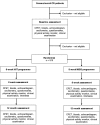High-intensity interval training versus moderate-intensity steady-state training in UK cardiac rehabilitation programmes (HIIT or MISS UK): study protocol for a multicentre randomised controlled trial and economic evaluation
- PMID: 27852718
- PMCID: PMC5129054
- DOI: 10.1136/bmjopen-2016-012843
High-intensity interval training versus moderate-intensity steady-state training in UK cardiac rehabilitation programmes (HIIT or MISS UK): study protocol for a multicentre randomised controlled trial and economic evaluation
Abstract
Introduction: Current international guidelines for cardiac rehabilitation (CR) advocate moderate-intensity exercise training (MISS, moderate-intensity steady state). This recommendation predates significant advances in medical therapy for coronary heart disease (CHD) and may not be the most appropriate strategy for the 'modern' patient with CHD. High-intensity interval training (HIIT) appears to be a safe and effective alternative, resulting in greater improvements in peak oxygen uptake (VO2 peak). To date, HIIT trials have predominantly been proof-of-concept studies in the laboratory setting and conducted outside the UK. The purpose of this multicentre randomised controlled trial is to compare the effects of HIIT and MISS training in patients with CHD attending UK CR programmes.
Methods and analysis: This pragmatic study will randomly allocate 510 patients with CHD to 8 weeks of twice weekly HIIT or MISS training at 3 centres in the UK. HIIT will consist of 10 high-intensity (85-90% peak power output (PPO)) and 10 low-intensity (20-25% PPO) intervals, each lasting 1 min. MISS training will follow usual care recommendations, adhering to currently accepted UK guidelines (ie, >20 min continuous exercise at 40-70% heart rate reserve). Outcome measures will be assessed at baseline, 8 weeks and 12 months. The primary outcome for the trial will be change in VO2 peak as determined by maximal cardiopulmonary exercise testing. Secondary measures will assess physiological, psychosocial and economic outcomes.
Ethics and dissemination: The study protocol V.1.0, dated 1 February 2016, was approved by the NHS Health Research Authority, East Midlands-Leicester South Research Ethics Committee (16/EM/0079). Recruitment will start in August 2016 and will be completed in June 2018. Results will be published in peer-reviewed journals, presented at national and international scientific meetings and are expected to inform future national guidelines for exercise training in UK CR.
Trial registration number: NCT02784873; pre-results.
Keywords: HEALTH ECONOMICS.
Published by the BMJ Publishing Group Limited. For permission to use (where not already granted under a licence) please go to http://www.bmj.com/company/products-services/rights-and-licensing/.
Conflict of interest statement
Conflicts of Interest: None declared.
Similar articles
-
High-intensity interval training in cardiac rehabilitation: a multi-centre randomized controlled trial.Eur J Prev Cardiol. 2023 Jul 12;30(9):745-755. doi: 10.1093/eurjpc/zwad039. Eur J Prev Cardiol. 2023. PMID: 36753063 Clinical Trial.
-
Short-term and Long-term Feasibility, Safety, and Efficacy of High-Intensity Interval Training in Cardiac Rehabilitation: The FITR Heart Study Randomized Clinical Trial.JAMA Cardiol. 2020 Dec 1;5(12):1382-1389. doi: 10.1001/jamacardio.2020.3511. JAMA Cardiol. 2020. PMID: 32876655 Free PMC article. Clinical Trial.
-
Effects of Exercise Training Response on Quality of Life and Cardiovascular Risk Factor Profiles in People With Coronary Artery Disease: Insights From the HIIT or MISS UK Trial.Arch Phys Med Rehabil. 2024 Aug;105(8):1464-1470. doi: 10.1016/j.apmr.2024.03.002. Epub 2024 Mar 16. Arch Phys Med Rehabil. 2024. PMID: 38493909 Clinical Trial.
-
Benefits and Risks of High-Intensity Interval Training in Patients With Coronary Artery Disease.Am J Cardiol. 2019 Apr 15;123(8):1370-1377. doi: 10.1016/j.amjcard.2019.01.008. Epub 2019 Jan 24. Am J Cardiol. 2019. PMID: 30732854 Review.
-
High-intensity Interval Training Dosage for Heart Failure and Coronary Artery Disease Cardiac Rehabilitation. A Systematic Review and Meta-analysis.Rev Esp Cardiol (Engl Ed). 2019 Mar;72(3):233-243. doi: 10.1016/j.rec.2018.02.015. Epub 2018 Apr 9. Rev Esp Cardiol (Engl Ed). 2019. PMID: 29650445 English, Spanish.
Cited by
-
Benefits of a Supervised Ambulatory Outpatient Program in a Cardiovascular Rehabilitation Unit Prior to a Heart Transplant: A Case Study.Front Cardiovasc Med. 2022 May 19;9:811458. doi: 10.3389/fcvm.2022.811458. eCollection 2022. Front Cardiovasc Med. 2022. PMID: 35665250 Free PMC article.
-
An "Exercise" in Cardiac Metabolism.Front Cardiovasc Med. 2018 Jun 7;5:66. doi: 10.3389/fcvm.2018.00066. eCollection 2018. Front Cardiovasc Med. 2018. PMID: 29930946 Free PMC article. Review.
-
High INtensity Interval Training In pATiEnts with intermittent claudication (INITIATE): protocol for a multicentre, proof-of-concept, prospective interventional study.BMJ Open. 2020 Jul 6;10(7):e038825. doi: 10.1136/bmjopen-2020-038825. BMJ Open. 2020. PMID: 32636290 Free PMC article.
-
Is exercise-based cardiac rehabilitation effective? A systematic review and meta-analysis to re-examine the evidence.BMJ Open. 2018 Mar 14;8(3):e019656. doi: 10.1136/bmjopen-2017-019656. BMJ Open. 2018. PMID: 29540415 Free PMC article.
-
Inter- and intra-observer reliability and agreement of O2Pulse inflection during cardiopulmonary exercise testing: A comparison of subjective and novel objective methodology.PLoS One. 2024 Mar 7;19(3):e0299486. doi: 10.1371/journal.pone.0299486. eCollection 2024. PLoS One. 2024. PMID: 38452129 Free PMC article.
References
-
- WHO. The top 10 causes of death. Fact sheet No. 310. World Health Organization, 2014. http://www.who.int/mediacentre/factsheets/fs310/en/ (updated May 2014).
-
- BHF. Coronary Heart Disease Statistics. A compendium of health statistics. 2012 edition, 2012.
-
- NICE. Secondary prevention after a myocardial infarction. NICE quality standard (QS99), 2015. https://www.nice.org.uk/guidance/qs99
Publication types
MeSH terms
Associated data
LinkOut - more resources
Full Text Sources
Other Literature Sources
Medical

